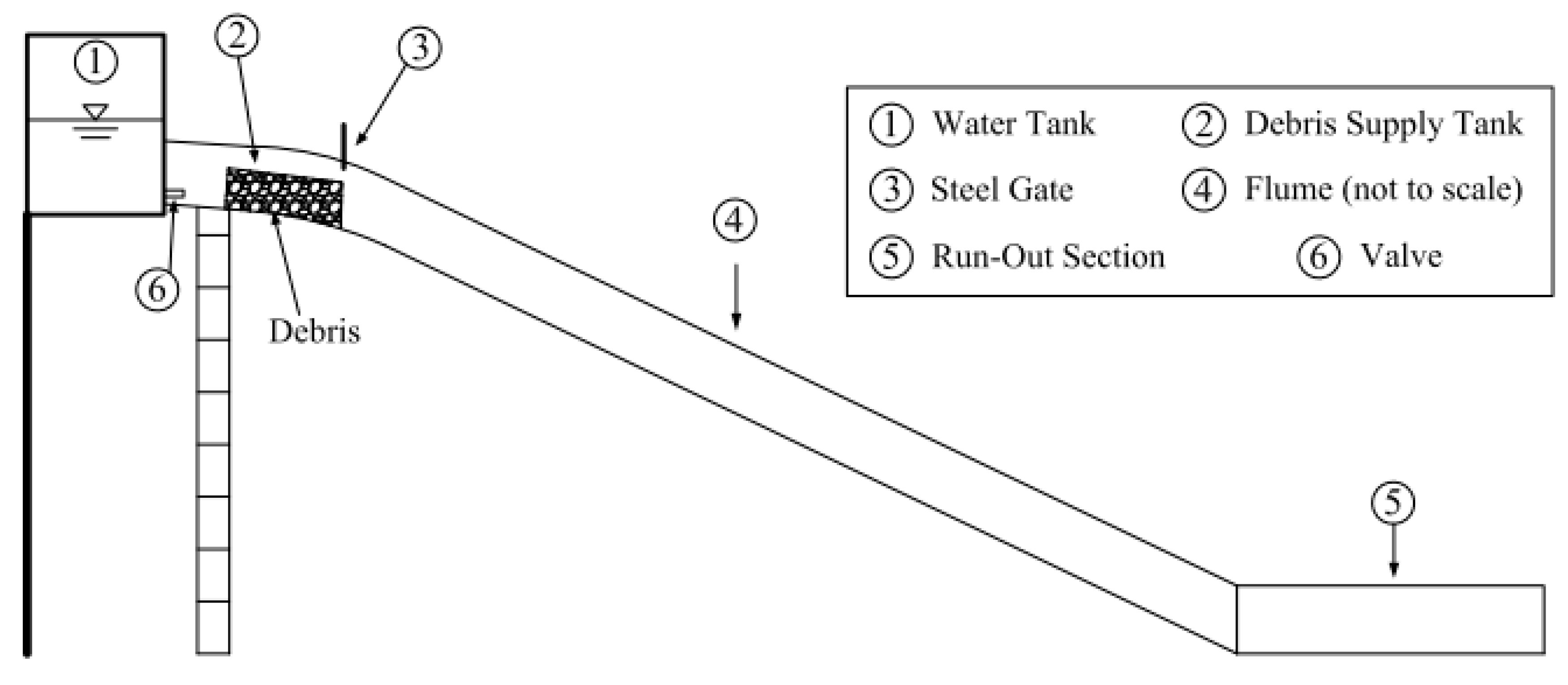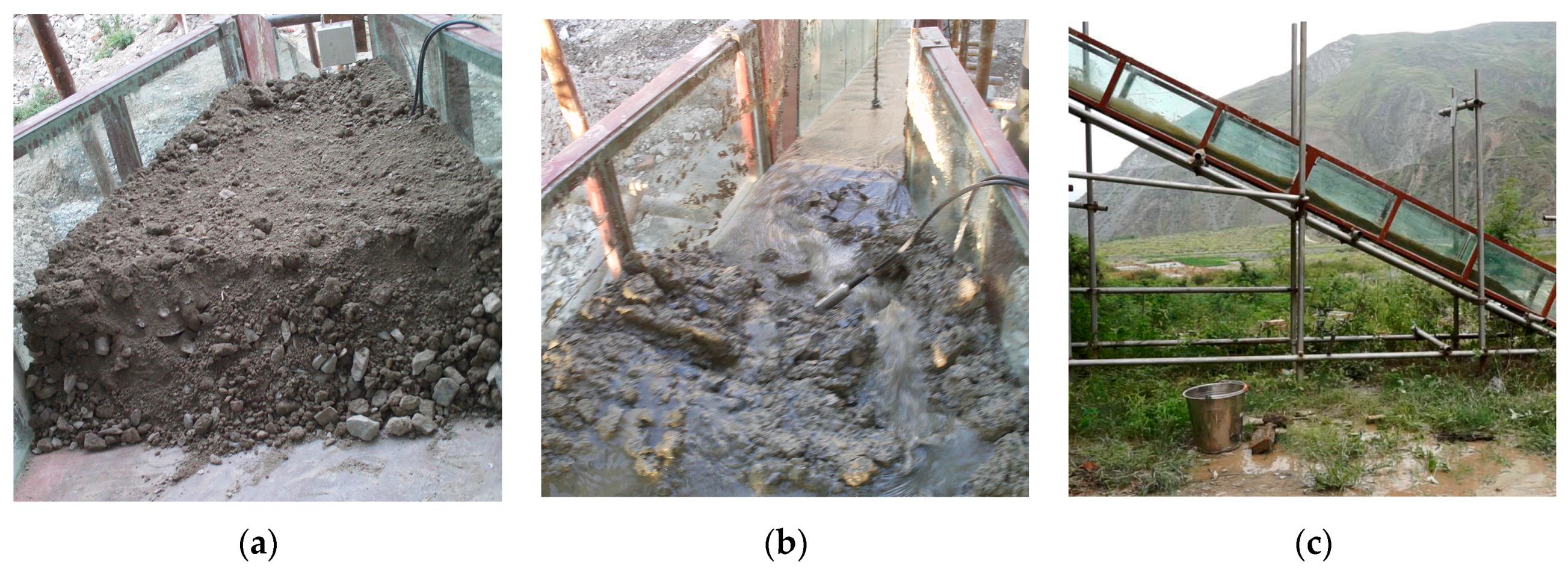2.1. Factor Selection
Steep topography, massive loose debris, and intense rainfall/runoff are prerequisites for debris-flow occurrence. In this regard, the influencing factors were selected to reflect these basic criteria as identifiable variables in detail. Therefore, both the median grain size
d50 and the way that coarse and fine particles were distributed in the vertical profile were used as a surrogate for debris condition, the flow rate and initial water content (or moisture content) within the debris were adopted as an index of the rainfall/run-off effect, and the steepness of the watershed could be represented by the flume slope. Thus, the five factors and test levels of each factor are shown in
Table 1.
The non-homogeneous debris flows are commonly modeled as two-phase flows because both fine and coarse particles play an important role in the composition and dynamic flow process. In a two-phase debris flow model, the fluid phase is composed of water and fine sediments that are less than the critical grain size
d0, with the solid phase consisting of grain sizes larger than
d0. In earlier studies, a constant critical value of
d0 = 2.0 mm [
32] was utilized due to the limitations of the rheological instruments. More recently, Shu et al. [
33] introduced a minimum energy dissipation modelling approach [
34] to determine
d0 for the experimental debris flows in the Jiangjia gully. Their results implied that the critical diameter
d0 could vary for the different types of debris flows, but with a predicted range of 4.0–7.0 mm.
In the case of loose debris collected from the Jiangjiagou valley, the three levels of median grain sizes
d50 were determined according to critical grain size
d0 to separate the liquid and solid phases within non-homogeneous debris flows from Shu et al. [
33,
35], that is, the median grain size
d50 is larger, close to, and smaller than the critical grain size
d0 (i.e., ≈4.0–6.0 mm), and hence the cumulative grading curves of experimental debris in the present study are shown in
Figure 1. The loose debris was originally from easily-weathered slate, dolomite, and phyllite with a density corresponding to 2.65 t/m
3.
In addition, it is to be emphasized that the way that coarse and fine particles appeared in the vertical profile within loose debris was also considered on the basis of three vertical depositing patterns (i.e., normal, mixed, and inverse grading) reported in the earlier studies [
36,
37,
38,
39,
40,
41]. However, these findings of the vertical grading patterns were generally restricted to the post-event analysis and alluvial deposits. The study of the vertical grading of debris in the initiation zone and their corresponding effects on the debris-flow dynamic process is relatively scarce. Because of this, three typical vertical grading patterns were considered herein and their influence on the debris-flow formation and initial transport will be examined.
Specifically, coarse particles placed at the bottom layer and fine sediment on the top layer (Case E1, see
Figure 2a), the coarse particles distributed on the top layer with fine grains at the bottom layer (Case E3, see
Figure 2b), and both the coarse and fine particles fully mixed and covering the whole vertical profile (Case E2, see
Figure 2c). In order to quantify this, a vertical grading coefficient
ψ was proposed and written as
where
d50-u and
d50-l represents the median grain size of the graded sediment on the top and bottom layer within the bulk debris, respectively. In this study, three basic debris fractions were used to generate a desirable mixture; fine debris with
d50 = 3.0 mm, coarse debris with
d50 = 7.0 mm, and an intermediate one with
d50 = 5.0 mm. Therefore, the vertical grading coefficient for the corresponding debris configurations can be
ψ = 0.43 for Case E1 (i.e., fine particles in the top layer and coarse particles at the basal layer, e.g.,
d50-u ≈ 3.0 mm,
d50-l ≈ 7.0 mm), and
ψ = 2.33 for Case E3 (coarse particles in the top layer and fine particles at the basal layer, e.g.,
d50-u ≈ 7.0 mm,
d50-l ≈ 3.0 mm), respectively. As for case E2, the mixture was generated by thoroughly mixing varying-sized particles that were placed uniformly through the vertical profile to produce a more homogeneous vertical grading pattern (i.e.,
d50-u ≈
d50-l ≈ 3.0, 5.0, 7.0 mm), therefore,
ψ = 1.00 for Case E2. In contrast, the test levels for the remaining factors (i.e., flow rate, flume slope, and initial water content) were determined by preliminary experiments.
In general, a more straightforward way to examine the influence of various factors is directly achieved through one-factor-at-a-time or mono-variate design, in which most factors in the system are held constant while one factor is focused on and varied to examine its effect [
42,
43]. However, this design method will lose its advantage if the number of investigated factors is increased. In contrast, the orthogonal experimental design is more desirable (i.e., gaining the desired result by reducing the number of experiments) in the present study when considering the number of factors and their test levels given in
Table 1.
2.2. Experimental Setup and Procedure
Our experiments were performed in a 9.0 m long, 0.3 m wide, 0.4 m deep flume established in the Debris Flow Observation and Research Station of Jiangjia Gully, the largest field research center in China which is also known as “the debris flow museum” [
23]. The facility (
Figure 3) consists of a water tank (5.0 m above the laboratory floor which stores water up to 1.2 m
3) with a valve at its base (the target flow can be generated by controlling the valve), a mixing supply tank followed by a steel gate, and flume divided into a steep upstream reach (6.0 m long and the chute slope can vary from 25° to 40°) and flat-oriented downstream section (3.0 m long and the flume bed slope can be adjusted from 1° to 5°).
Prior to each run, the debris mixtures were carefully placed in the supply tank (see
Figure 3) according to the initial water content (
Table 1) and vertical grading coefficient (
Table 1 and
Figure 2), the volume of solid debris was estimated to be around
Vs ≈ 0.10 m
3 and remained approximately constant between runs, and then the pore-water pressure sensors (the sensor model is 730-13E-00005 manufactured by a PSI Pressure System company that located at Baytown, TX, USA; the range is a 1.5 m water column; the precision is a 1 mm water column; the operating temperature range is between 0° and 40°) were buried in four locations at 0.3
H, in which
H is the height of the debris prior to testing. These sensors are quite small and have a negligible effect on the initial flow formation.
After this, the valve of the water tank was opened to a pre-determined position with the purpose of generating the target flow (i.e., constant flow), and the variability in the flow infiltration level within the mass entity prior to the debris-flow occurrence was accordingly monitored by a video-camera through the transparent wall at one side of the flume (Note: the steel gate was not used in all tests). Initially, the flow was blocked by the debris materials, and when the water level and associated pressure was increased, then a small volume of water flow was found to penetrate through the stable debris materials. For most of the tests, the water flow passed through the debris mass. However, in some tests with high Q, the water flow accumulated so quickly to make it capable of not only going through the granular mass, but also passing over the surface of the granular mass. Colored plastic beads that “floated” on the debris-flow surface were used as tracers to derive the average flow velocity as the flow depths were commonly low (i.e., h = 0.033–0.147 m). When the mass collapsed, entrained, and formed into a debris flow, the valve was closed and the total flow volume that contributed to the formation of the debris flow was calculated. Individual sediment samples collected from the debris-flow deposition were subsequently dried in an oven, weighed, and sieved for further analysis.
2.3. Debris-Flow Formation and Initial Transport
In this study, the debris-flow formation, initiation, and subsequent transport was a continuous mixture-mobilized process. In order to examine the effect of the five factors on the debris-flow formation, the formative duration Δ
Tdff (s) of a debris flow observed within the flume was firstly proposed, namely the duration of the debris-flow formation was equivalent to the length of time from the start of experiment to the initiation of the debris-flow mobilization (see
Figure 4a,b). Generally, the shorter the formative duration Δ
Tdff measured, the more conducive the conditions for the debris-flow formation/initiation were likely to be. Once the valve of the water tank was opened, the experiment was started and timely recorded; while the initiation of debris flow was defined as the point at which the materials were flooded, mixed, and suddenly entered the flume section. As the debris-flow initiation and transport happened almost simultaneously, the initiation was also defined as the time right before or coincided with a sudden mobilization of the debris-flow mixture into the flume. In each test, the volume of clear water and solid materials that were involved in the debris-flow formation could be roughly estimated as
.
Secondly, the initial transport following the debris-flow initiation is described by the observed surface velocity
u and Froude number
Fr (see
Figure 4c). Here, the debris-flow Froude number can be expressed in terms of debris-flow (average) velocity as
where
u is the mean debris-flow velocity (m/s),
h is the debris-flow depth (m) measured at 4.0–5.0 m from the flume upstream end, and
g is the gravitational acceleration (m/s
2). Note that the velocity and Froude number in this study were restricted to the initial transport of debris flows, that is, when the debris-flow mixture entered into the flume and moved towards the downstream end.









